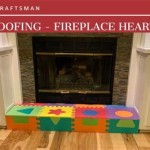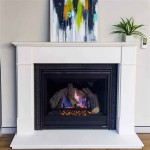Understanding Rear Vent Fireplaces: Design, Functionality, and Considerations
Rear vent fireplaces represent a specific type of fireplace design characterized by their flue or vent exiting through the back of the firebox, rather than the top, as is common in more conventional fireplace structures. This distinctive design element allows for unique installation possibilities and aesthetic considerations, often influencing the overall layout and design of a room. Understanding the nuances of rear vent fireplaces, including their advantages, disadvantages, installation requirements, and maintenance considerations, is crucial for homeowners and building professionals alike.
The location of the vent significantly impacts the fireplace's performance, installation options, and overall aesthetic appeal. While top-vented fireplaces traditionally occupy a central position within a room, a rear vent fireplace can be situated against a wall, offering space-saving possibilities. This design frequently appeals to individuals seeking a minimalist aesthetic or those with space constraints that make traditional top-vented installations impractical. The rear venting system also influences the complexity of the installation process and may require specialized expertise to ensure proper functionality and safety.
This article explores the various facets of rear vent fireplaces, delving into their operational principles, design considerations, installation specifics, and maintenance requirements. By providing a comprehensive overview, the aim is to equip readers with the necessary knowledge to make informed decisions regarding the selection, installation, and upkeep of rear vent fireplaces.
Key Point 1: Advantages and Disadvantages of Rear Vent Fireplaces
The primary advantage of a rear vent fireplace centers around its design flexibility. The vent's rearward exit allows for a flush-to-wall installation, maximizing floor space and contributing to a streamlined aesthetic. This is particularly beneficial in smaller rooms or modern homes where space optimization is a priority. The design also facilitates corner installations, providing unique focal point opportunities within a room's layout. Furthermore, the concealed venting system can contribute to a cleaner exterior appearance, as the chimney is often less visible than in traditional top-vented designs.
However, rear vent fireplaces also come with specific disadvantages. The installation process can be more complex and expensive than with top-vented models. The venting system often requires horizontal runs before transitioning to a vertical chimney, potentially necessitating the construction of a chase or the routing of the vent through existing wall cavities. This horizontal run can also negatively impact draft if not carefully engineered and installed, potentially leading to smoke spillage into the room. Maintaining proper draft and preventing backdrafting are critical concerns that must be addressed during the installation phase.
Another potential disadvantage concerns cleaning and maintenance. Horizontal vent runs are more prone to creosote buildup in wood-burning models, necessitating more frequent cleaning to prevent chimney fires. The design also often requires specific types of connectors and adapters, which may increase the overall cost of the installation. Finally, the limited availability of rear vent fireplace models compared to top-vented options can restrict design choices and potentially increase the overall project cost.
Key Point 2: Installation Considerations and Regulations
The installation of a rear vent fireplace is governed by strict building codes and safety regulations. Adherence to these codes is paramount to ensure safe and efficient operation. Local building officials should be consulted prior to installation to determine specific requirements in the region. These regulations typically dictate the acceptable materials for the venting system, minimum clearances to combustible materials, and proper chimney height for adequate draft.
The venting system itself is a critical component of a rear vent fireplace. The chimney or vent needs to be designed and installed to ensure a proper draft, facilitating the efficient removal of combustion gases. Incorrect venting can lead to smoke spillage, carbon monoxide buildup, and potential fire hazards. The venting system must be properly sized to match the fireplace's heat output, and the horizontal run should be kept as short as possible to minimize resistance to airflow. Insulating the vent pipe is also advisable to maintain flue gas temperatures and further enhance draft.
Clearances to combustible materials are another essential consideration. Fireplaces and vent pipes generate significant heat, and it is crucial to maintain adequate separation from flammable materials such as wood framing, drywall, and insulation. Building codes specify minimum clearance distances, which vary depending on the type of venting system used. Heat shields or other protective measures may be needed to reduce clearance requirements in certain situations. Professional installation is strongly recommended to ensure compliance with all applicable codes and safety standards.
Consideration should also be given to the accessibility of the venting system for future maintenance and inspection. Providing access panels or removable sections can greatly simplify cleaning and repairs. The chimney or vent termination point must also be located in accordance with local regulations, ensuring proper draft and preventing smoke from entering the building or neighboring properties.
Key Point 3: Maintenance and Safety Protocols for Rear Vent Fireplaces
Regular maintenance is essential for ensuring the safe and efficient operation of a rear vent fireplace. The frequency of maintenance depends on the type of fuel used, the frequency of use, and the design of the venting system. Wood-burning fireplaces require more frequent cleaning than gas or electric models due to the creosote buildup, a highly flammable byproduct of wood combustion. Creosote accumulation can significantly increase the risk of chimney fires.
A qualified chimney sweep should inspect and clean the chimney or vent at least once a year, or more frequently if heavy use is anticipated. The inspection will identify any potential problems, such as cracks in the flue liner, blockages in the venting system, or excessive creosote buildup. Cleaning the chimney involves removing creosote and other debris from the vent walls, ensuring proper airflow and reducing the risk of fire. It's also important to inspect the firebox for any signs of damage or deterioration.
Using seasoned firewood is crucial for wood-burning fireplaces. Green or unseasoned wood has a higher moisture content, which leads to increased creosote production and a less efficient burn. Seasoned wood should be dried for at least six months before use, resulting in a cleaner and hotter fire. Furthermore, it is advisable to burn hardwoods, such as oak or maple, as they produce less creosote compared to softwoods like pine.
For gas fireplaces, regular maintenance typically involves inspecting the burner assembly, cleaning the pilot light, and checking for gas leaks. A qualified technician should perform these tasks to ensure the appliance operates safely and efficiently. Electric fireplaces require minimal maintenance, primarily consisting of cleaning the glass and dusting the unit. Regardless of the fuel type, it is essential to follow the manufacturer's recommendations for maintenance and safety.
Carbon monoxide detection is paramount for any fireplace, regardless of its venting configuration. Carbon monoxide is a colorless, odorless gas that can be deadly. Installing carbon monoxide detectors on every level of the home, particularly near sleeping areas, is a crucial safety precaution. Detectors should be tested regularly and batteries replaced as needed.
Understanding How Direct Vent Works Heat Glo

Benefits Of Direct Vent Fireplaces

Superior Fireplaces Drt2045 45 Direct Vent Fireplace Top Rear
Gas Fireplace Venting Explained Heat Glo

How Direct Vent Fireplaces Work
.aspx?strip=all)
Benefits Of Direct Vent Fireplaces Regency Fireplace S
Gas Fireplace Venting Explained Heat Glo

40 039 Dv Top Rear Vent Trad Electronic Ignition Gas Fireplace Lp

Superior Drt2045 Merit Series 45 Top Rear Vent Fireplace With Aged Oak Logs Millivolt

Superior Drt4240 40 Direct Vent Electronic Ignition Top Rear Fireplaces Usa
Related Posts








